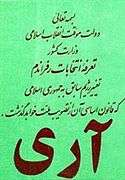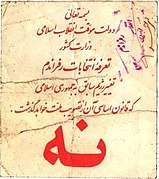March 1979 Iranian Islamic Republic referendum
A referendum on creating an Islamic Republic was held in Iran on 30 and 31 March 1979.
| Islamic Republic referendum | ||||||||||||||||
|---|---|---|---|---|---|---|---|---|---|---|---|---|---|---|---|---|
| In the Name of the Almighty [God] Provisional Government of Islamic Revolution The Interior Ministry Referendum Election Ballot Age-old [monarchial] regime change to Islamic republic, the constitution of which will be approved by the nation — Yes or No?[1] | ||||||||||||||||
The two-parts ballot of referendum, with the green paper indicating "Yes" and red paper indicating "No"[1] | ||||||||||||||||
| Location | Iran | |||||||||||||||
| Date | 30—31 March 1979[2] / 1358 SH | |||||||||||||||
| ||||||||||||||||
Although some groups objected to the wording and choice and boycotted the referendum,[4] it was approved by 98.2% of eligible citizens, according to official results.[3] No group campaigned for a no vote in the referendum.[5]
In order to include the Iranian youth who participated in the revolution, the voting age was lowered from 18 to 16.[3]
Following this victory, the 1906 constitution was declared invalid and a new constitution for an Islamic state was created and ratified by another referendum in December 1979.
Party policies
Alternative wordings proposed
What the nation wants is an Islamic Republic, not one word more and not one word less. Not just a Republic, not a democratic Republic, not a democratic Islamic Republic. Do not use the word 'democratic' to describe it. This the Western style.
When the authorities were preparing to prescribe a name for future political system, the parties called for a referendum open to give third choices, other than monarchy and Islamic Republic. Some of the names suggested were:
- "Islamic Republic of Iran", by Islamic Republican Party[6]
- "People's Republic of Iran", by leftists[6]
- "Democratic Republic of Iran", by leftists[4]
- "Democratic Islamic Republic of Iran", by Freedom Movement of Iran[6]
- "Republic of Iran", by secular nationalists[4]
Voting

The Interim Government of Iran invited a four-man delegation of international jurists from International Association of Democratic Lawyers to monitor the voting.[12] According to the Washington Post, polling places lacked voting booth and the colored ballots could clearly be seen by observers, quoting head of the delegation "this is not the way we do things in the West, and it does not meet our criteria of democracy".[13] Sadegh Zibakalam describes the referendum as "free and fair".[14] Michael Axworthy states "there may have been some irregularities in the referendum, but most balanced observers then and since have accepted that whatever the conditions, a referendum at that time with that question would always have given a massive majority for the same result".[15]
A huge voter turnout was reported nationwide, except for Turkmen Sahra and Iranian Kurdistan, where the referendum was held partially due to the armed conflicts ongoing.[16]
Results
| Choice | Votes | % |
|---|---|---|
| For | 20,147,855 | 99.3 |
| Against | 140,996 | 0.7 |
| Valid Votes | 20,288,851 | 100 |
| Source: Nohlen et al[2] | ||
| Choice | Votes |
|---|---|
| Number of Eligible Voters | 20,857,391 |
| Number of Actual Voters | 20,440,108 |
| Voter Turnout | 98% |
| Source: Iran Social Science Data Portal[17] | |
See also
References
- Hovsepian-Bearce, Yvette (2015). The Political Ideology of Ayatollah Khamenei: Out of the Mouth of the Supreme Leader of Iran. Routledge. p. 13. ISBN 1317605829.
- Nohlen, Dieter; Grotz, Florian; Hartmann, Christof (2001). "Iran". Elections in Asia: A Data Handbook. I. Oxford University Press. p. 68. ISBN 0-19-924958-X.
- Hiro, Dilip (2013). Holy Wars (Routledge Revivals): The Rise of Islamic Fundamentalism. Routledge. p. 169. ISBN 1135048312.
- Paydar, Parvin (1995). Women and the Political Process in Twentieth-Century Iran. Cambridge University Press. p. 226. ISBN 978-0-521-59572-8.
- Chehabi, Houchang Esfandiar (1986). Modernist Shi'ism and Politics: The Liberation Movement of Iran (PhD Dissertation). I/II. Yale University. p. 499. ASIN B0007CAVDC.
- Baktiari, Bahman (1996). Parliamentary Politics in Revolutionary Iran: The Institutionalization of Factional Politics. University Press of Florida. p. 55. ISBN 978-0-8130-1461-6.
- Haddad Adel, Gholamali; Elmi, Mohammad Jafar; Taromi-Rad, Hassan. Political Parties: Selected Entries from Encyclopaedia of the World of Islam. EWI Press. pp. 209–215. ISBN 9781908433022.
- Hiro, Dilip (2013). Iran Under the Ayatollahs (Routledge Revivals). Routledge. p. 128. ISBN 1135043817.
- Maziar, Behrooz (2000). Rebels With A Cause: The Failure of the Left in Iran. I.B.Tauris. p. 109. ISBN 1860646301.
- Romano, David (2006). The Kurdish Nationalist Movement: Opportunity, Mobilization and Identity. Cambridge Middle East studies, 22. Cambridge University Press. p. 236. ISBN 978-0-521-85041-4. OCLC 61425259.
- Ganji, Manouchehr (2002). Defying the Iranian Revolution: From a Minister to the Shah to a Leader of Resistance. Greenwood Publishing Group. p. 77. ISBN 0275971872.
- Albala, Nuri; Dossou, Robert; Dreyfus, Nicole; Youssoufi, Abderahmane (May 1979), Commission internationale d'enquete en Iran sur la preparation et le deroulement du referendum des 30 et 31 mars, la situation actuelle des droits de Phomme et la mise en place des nouvelles institutions, les crimes du regime Pahlavi (in French), Association Internationale des Juristes DémocratesCS1 maint: uses authors parameter (link)
- Ronald Koven (2 April 1979). "Khomeini Decrees Islamic Republic After Vote in Iran". Washington Post. Retrieved 25 January 2017.
- Sadegh Zibakalam (2014). "To Rule or Not to Rule? An Alternative Look at the Political Life of Ayatollah Khomeini between 1960 and 1980". In Arshin Adib-Moghaddam (ed.). A Critical Introduction to Khomeini. Cambridge University Press. p. 272. ISBN 978-1-107-72906-3.
- Axworthy, Michael (2013), Revolutionary Iran: A History of the Islamic Republic, Oxford University Press, pp. 373–374
- "Landslide Victory for Khomeini Reported in Voting". The New York Times. 2 April 1979. Retrieved 25 January 2017.
- "Referenda", The Iran Social Science Data Portal, Princeton University, retrieved 10 August 2016

